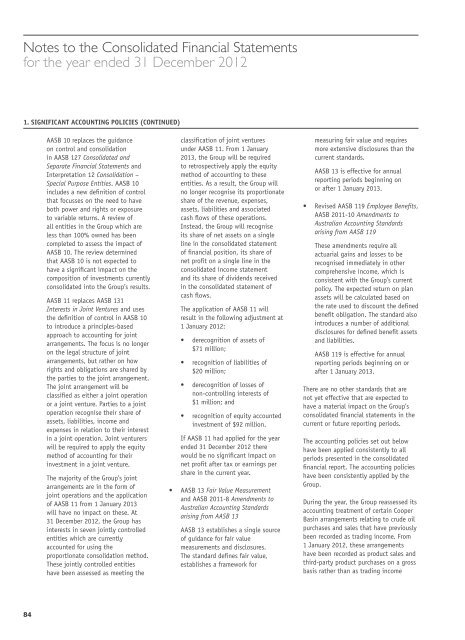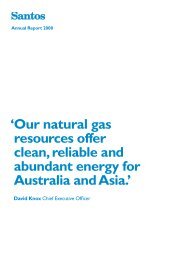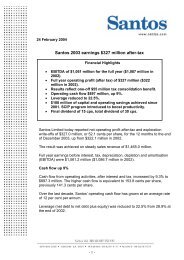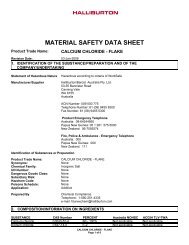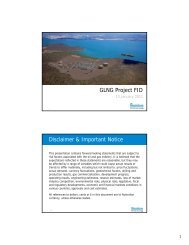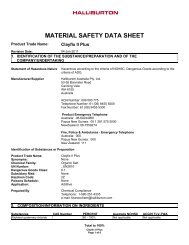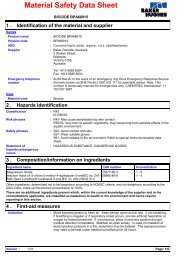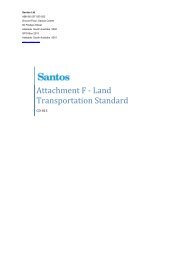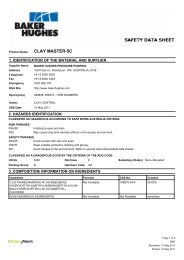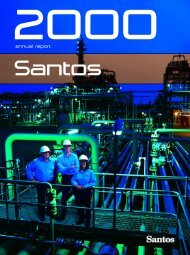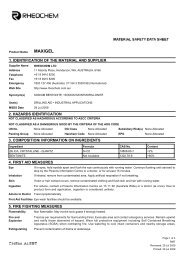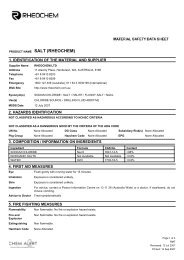Financials - Santos
Financials - Santos
Financials - Santos
Create successful ePaper yourself
Turn your PDF publications into a flip-book with our unique Google optimized e-Paper software.
Notes to the Consolidated Financial Statements<br />
for the year ended 31 December 2012<br />
1. Significant Accounting Policies (continued)<br />
AASB 10 replaces the guidance<br />
on control and consolidation<br />
in AASB 127 Consolidated and<br />
Separate Financial Statements and<br />
Interpretation 12 Consolidation –<br />
Special Purpose Entities. AASB 10<br />
includes a new definition of control<br />
that focusses on the need to have<br />
both power and rights or exposure<br />
to variable returns. A review of<br />
all entities in the Group which are<br />
less than 100% owned has been<br />
completed to assess the impact of<br />
AASB 10. The review determined<br />
that AASB 10 is not expected to<br />
have a significant impact on the<br />
composition of investments currently<br />
consolidated into the Group’s results.<br />
AASB 11 replaces AASB 131<br />
Interests in Joint Ventures and uses<br />
the definition of control in AASB 10<br />
to introduce a principles-based<br />
approach to accounting for joint<br />
arrangements. The focus is no longer<br />
on the legal structure of joint<br />
arrangements, but rather on how<br />
rights and obligations are shared by<br />
the parties to the joint arrangement.<br />
The joint arrangement will be<br />
classified as either a joint operation<br />
or a joint venture. Parties to a joint<br />
operation recognise their share of<br />
assets, liabilities, income and<br />
expenses in relation to their interest<br />
in a joint operation. Joint venturers<br />
will be required to apply the equity<br />
method of accounting for their<br />
investment in a joint venture.<br />
The majority of the Group’s joint<br />
arrangements are in the form of<br />
joint operations and the application<br />
of AASB 11 from 1 January 2013<br />
will have no impact on these. At<br />
31 December 2012, the Group has<br />
interests in seven jointly controlled<br />
entities which are currently<br />
accounted for using the<br />
proportionate consolidation method.<br />
These jointly controlled entities<br />
have been assessed as meeting the<br />
classification of joint ventures<br />
under AASB 11. From 1 January<br />
2013, the Group will be required<br />
to retrospectively apply the equity<br />
method of accounting to these<br />
entities. As a result, the Group will<br />
no longer recognise its proportionate<br />
share of the revenue, expenses,<br />
assets, liabilities and associated<br />
cash flows of these operations.<br />
Instead, the Group will recognise<br />
its share of net assets on a single<br />
line in the consolidated statement<br />
of financial position, its share of<br />
net profit on a single line in the<br />
consolidated income statement<br />
and its share of dividends received<br />
in the consolidated statement of<br />
cash flows.<br />
The application of AASB 11 will<br />
result in the following adjustment at<br />
1 January 2012:<br />
• derecognition of assets of<br />
$71 million;<br />
• recognition of liabilities of<br />
$20 million;<br />
• derecognition of losses of<br />
non‐controlling interests of<br />
$1 million; and<br />
• recognition of equity accounted<br />
investment of $92 million.<br />
If AASB 11 had applied for the year<br />
ended 31 December 2012 there<br />
would be no significant impact on<br />
net profit after tax or earnings per<br />
share in the current year.<br />
• AASB 13 Fair Value Measurement<br />
and AASB 2011‐8 Amendments to<br />
Australian Accounting Standards<br />
arising from AASB 13<br />
AASB 13 establishes a single source<br />
of guidance for fair value<br />
measurements and disclosures.<br />
The standard defines fair value,<br />
establishes a framework for<br />
measuring fair value and requires<br />
more extensive disclosures than the<br />
current standards.<br />
AASB 13 is effective for annual<br />
reporting periods beginning on<br />
or after 1 January 2013.<br />
• Revised AASB 119 Employee Benefits,<br />
AASB 2011‐10 Amendments to<br />
Australian Accounting Standards<br />
arising from AASB 119<br />
These amendments require all<br />
actuarial gains and losses to be<br />
recognised immediately in other<br />
comprehensive income, which is<br />
consistent with the Group’s current<br />
policy. The expected return on plan<br />
assets will be calculated based on<br />
the rate used to discount the defined<br />
benefit obligation. The standard also<br />
introduces a number of additional<br />
disclosures for defined benefit assets<br />
and liabilities.<br />
AASB 119 is effective for annual<br />
reporting periods beginning on or<br />
after 1 January 2013.<br />
There are no other standards that are<br />
not yet effective that are expected to<br />
have a material impact on the Group’s<br />
consolidated financial statements in the<br />
current or future reporting periods.<br />
The accounting policies set out below<br />
have been applied consistently to all<br />
periods presented in the consolidated<br />
financial report. The accounting policies<br />
have been consistently applied by the<br />
Group.<br />
During the year, the Group reassessed its<br />
accounting treatment of certain Cooper<br />
Basin arrangements relating to crude oil<br />
purchases and sales that have previously<br />
been recorded as trading income. From<br />
1 January 2012, these arrangements<br />
have been recorded as product sales and<br />
third-party product purchases on a gross<br />
basis rather than as trading income<br />
84


